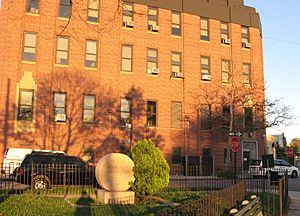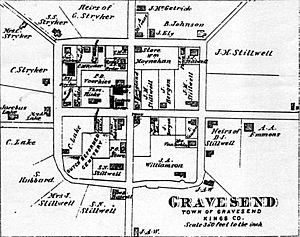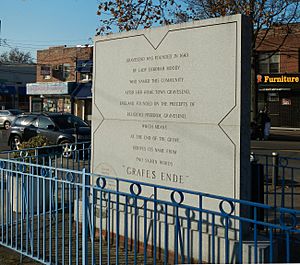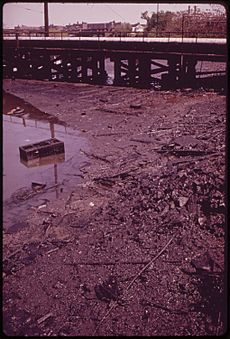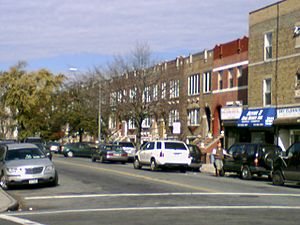Gravesend, Brooklyn facts for kids
Quick facts for kids
Gravesend
|
|
|---|---|
|
Neighborhood of Brooklyn
|
|
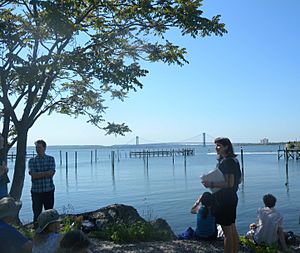
Looking at Lower New York Bay from Gravesend (2012)
|
|
| Etymology: see below | |
| Country | |
| State | |
| City | New York City |
| Borough | Brooklyn |
| Area | |
| • Total | 1.144 sq mi (2.962 km2) |
| Population
(2010)
|
|
| • Total | 29,436 |
| • Density | 25,739/sq mi (9,937.9/km2) |
| Ethnicity | |
| • White | 52.8% |
| • Asian | 21.2 |
| • Hispanic | 16.0 |
| • Black | 8.4 |
| • Other | 1.5 |
| ZIP Code |
11223
|
| Area code(s) | 718, 347, 929, and 917 |
Gravesend is a neighborhood in the southern part of Brooklyn, one of the five boroughs of New York City. It's located on the southwestern edge of Long Island in New York. The area is bordered by the Belt Parkway to the south, Bay Parkway to the west, Avenue P to the north, and Ocean Parkway to the east.
Gravesend was one of the first towns in the Dutch colony of New Netherland. When the English took over, it became one of the original six towns in Kings County, New York. It's special because it was the only English town in Kings County with its own charter. It's also famous for being one of the first towns founded by a woman, Lady Deborah Moody. The original Town of Gravesend covered about 7,000 acres, including all of Coney Island. It became part of the City of Brooklyn in 1894.
Today, Gravesend is part of Brooklyn Community Board 11 and Brooklyn Community Board 13. In 2010, about 29,436 people lived there.
Contents
What's in a Name?
The exact meaning of the name "Gravesend" isn't fully clear. Some people think it was named after the English seaport of Gravesend, Kent. Another idea is that it was named by Willem Kieft after a Dutch settlement called "'s-Gravesande." This Dutch name means "Count's Beach" or "Count's Sand." There is still a town in the Netherlands called 's-Gravenzande.
Where is Gravesend?
The Gravesend neighborhood is located between Coney Island Avenue to the east and Stillwell Avenue to the west. To the north is Kings Highway, and to the south are Coney Island Creek and Shore Parkway. Nearby neighborhoods include Sheepshead Bay to the east, Midwood to the northeast, Bensonhurst to the northwest, and Bath Beach to the west. Across Coney Island Creek to the south is Coney Island, and across Shore Parkway is Brighton Beach.
The original center of the old town is still important. It's a four-block area where the Moody House and the Van Sicklen family cemetery are located. Right next to the Van Sicklen cemetery is the Old Gravesend Cemetery. Lady Moody is thought to be buried there. This cemetery also has an interesting resident: Mohammad Ben Misoud from Egypt, who was part of a Coney Island show and had a proper Muslim funeral when he died in 1896.
Gravesend has good public transportation with three New York City Subway lines. These are the D train line at 25th Avenue and Bay 50th Street, the F <F> trains line at Kings Highway, Avenue U, and Avenue X, and the N W trains line at Kings Highway, Avenue U, and 86th Street. The Coney Island subway yard, where subway trains are stored and repaired, is also in the neighborhood. The local police department patrols Gravesend with officers from the 60th, 61st, and 62nd Precincts.
Gravesend's Story
Early Days
The area that is now Gravesend was first home to groups of Lenape people. The first European known to visit this land was Henry Hudson. His ship, the Half Moon, landed on Coney Island in the fall of 1609.
Later, the land became part of the New Netherland Colony. In 1643, it was given to Deborah Moody. She was an English woman who wanted to create a community where she and her followers could practice their religious beliefs freely. Because of conflicts with local native tribes, the town wasn't fully built until 1645. But when the town charter was signed, it was one of the first times a woman was given such a title in the New World.
The town Lady Moody created was one of America's first planned communities. It was a perfect square surrounded by a 20-foot-high wooden fence. Two main roads crossed the town: Gravesend Road (now McDonald Avenue) running north-south, and Gravesend Neck Road running east-west. These roads divided the town into four sections, each with ten plots of land. You can still see this original grid pattern on maps today. At the center, where the roads met, a town hall was built for monthly meetings. Lady Moody is believed to be buried in Old Gravesend Cemetery.
Gravesend's early religious freedom made it a welcoming place for groups who were not accepted elsewhere, like the Quakers. They lived there for a short time before being asked to leave by New Netherland director general Peter Stuyvesant, who was worried about Gravesend accepting different religious groups.
In 1654, the people of Gravesend bought Coney Island from the local native people. They paid with items worth about $15, like seashells, guns, and gunpowder.
In August 1776, thousands of British soldiers and German fighters landed in Gravesend Bay. This led to the Battle of Long Island (also called the Battle of Brooklyn). The troops faced little resistance from the American army led by General George Washington. This battle was the first and largest battle of the entire American Revolutionary War.
Growing Popularity
For a long time, Gravesend was a quiet suburb. But in the late 1800s, things changed. Three big racetracks opened (Sheepshead Bay Race Track, Gravesend Race Track, and Brighton Beach Race Course), and Coney Island became a very popular vacation spot. This turned Gravesend into a busy resort community.
A man named John Y. McKane played a big role in this growth. He started as a carpenter and became a powerful figure in Gravesend. He held many important jobs, like town supervisor and police chief. From the 1870s to the 1890s, McKane helped develop Coney Island, which was part of Gravesend at the time. He expanded the police force and often patrolled the beach himself.
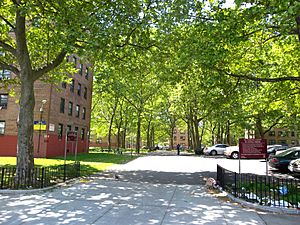
McKane also made Gravesend's politics unfair. He allowed many people to vote, even those who weren't U.S. citizens or who had passed away. This caused a lot of problems. In 1893, a lawyer named William Gaynor tried to check McKane's voting methods. He sent observers to Gravesend to watch the election. But McKane and his group stopped them. McKane reportedly said, "injunctions don't go here" and ordered the men away. Some observers were hurt and arrested. This event caused a lot of anger. McKane was later sent to prison for six years. He was released and died in 1899.
After McKane was removed, Gravesend and Coney Island became part of the city of Brooklyn in 1894. This also allowed George C. Tilyou to create one of Coney Island’s first amusement parks, Steeplechase Park. This park helped start Coney Island’s "golden age" of amusement.
Around the same time, in the late 1800s, Gravesend was a testing ground for the Boynton Bicycle Railroad. This was an early type of monorail. It used a single-wheeled engine that pulled two passenger cars along one track. A second rail above the train kept it from falling over. The train was only four feet wide and could go much faster than regular trains. In 1889, it ran a short route between the Gravesend stop of the Sea Beach Railroad and Brighton Beach in Coney Island. Even though it was smooth and fast, the Boynton Bicycle Railroad didn't succeed. The test route and train were eventually abandoned.
Recent Times
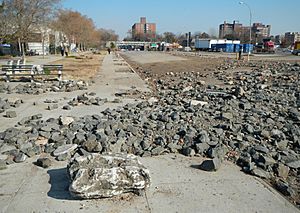
While Coney Island remained a popular tourist spot, Gravesend itself became a quieter residential neighborhood after its big racetracks closed in the early 1900s. Most of it became home to working and middle-class families. In the 1950s, the city built the Marlboro Houses, a large public housing complex with 28 buildings. It is managed by the New York City Housing Authority.
In the 1980s, there were some tensions between different groups of people living in Gravesend. For example, in 1988, a march was held to protest unfair treatment. The march started at the Marlboro Houses and went to a police station.
Starting in the 1990s, many Sephardi Jews (especially Syrian Jews) moved into the northeast part of the neighborhood. This led to the building of many new, expensive single-family homes.
Learning in Gravesend
Schools
- Big Apple Academy
- John Dewey High School
- Lafayette Educational Complex
- Touro College
- PS 95 The Gravesend
- PS 216 Arturo Toscanini
- PS 212 Lady Deborah Moody
- PS 721K Brooklyn Occupational Center
- IS 281 Joseph B. Cavallaro
- IS 228 David A. Boody
- Shostakovich School of Music
- PS 215 Morris H. Weiss
- PS 238 Anne Sullivan (Pre-K - 8)
- Our Lady of Grace Catholic Academy
- St Simon and St Jude Catholic School (k-8)
- PS 97 The Highlawn
Library
The Brooklyn Public Library has a Gravesend branch. It is located at 303 Avenue X near West 2nd Street. The library first opened in 1962 and was updated in 2001.
Who Lives in Gravesend?
According to information from the 2010 United States Census, Gravesend had 29,436 people living there. This was a small increase from the 29,257 people counted in 2000. The neighborhood covers about 731.83 acres.
In 2010, the population was made up of different groups:
- 52.8% White
- 21.2% Asian
- 8.4% African American
- 16.0% Hispanic or Latino (of any race)
- Other groups made up the rest.
More recent data from the New York City Department of City Planning in 2020 shows that different parts of Gravesend have varying populations. West Gravesend has many white and Asian residents. South Gravesend has more white residents, with fewer Asian, Hispanic, and Black residents. East Gravesend, which overlaps with Homecrest, has a higher number of white residents, along with many Hispanic and Asian residents. The Marlboro Houses, a housing development, is home to a large number of Black residents, as well as some Asian and Hispanic residents.
A Look at History
The first European settlers in Gravesend were mostly English and Dutch. In the past, slavery was legal, and many settlers used enslaved African Americans as workers. After slavery was ended in New York, African Americans continued to live and work in Gravesend, often settling near the BMT Brighton Line at East 16th Street.
The Gravesend Race Track, which is no longer open, started in 1886. It mainly hired Black workers, who often lived nearby. Later, many Irish, Italian, and Jewish people moved to Gravesend from Manhattan. More recently, immigrants from China, Mexico, Puerto Rico, Russia, Ukraine, and the Caribbean have made Gravesend their home. The largest group is thought to be Italian American, especially those from Castellammare del Golfo, Sicily. There's even a professional soccer team named the Brooklyn Italians, who play at John Dewey High School's stadium in Gravesend.
In 2008, The New York Times reported that Gravesend had become very popular with Sephardic Jews, especially Syrian Jews. The newspaper also noted that in the 2012 presidential election, Gravesend was one of the few areas in New York City where Mitt Romney received more votes than Barack Obama.
Getting Around Gravesend
Gravesend is served by three New York City Subway lines:
- The D train line stops at 25th Avenue and Bay 50th Street.
- The F <F> trains line stops at Kings Highway, Avenue U, and Avenue X.
- The N W trains line stops at Kings Highway, Avenue U, and 86th Street.
The Coney Island Subway Yard, a large area where subway trains are stored and maintained, is also in the neighborhood.
Several city bus lines also run through Gravesend, including the B1, B3, B4, B64, B68, B82, B82 SBS lines.
Famous People from Gravesend
- William DeMeo (born 1971), an actor
- John Franco (born 1960), a former New York Mets baseball player
Police Services
The New York City Police Department patrols Gravesend using officers from the 60th, 61st, and 62nd Precincts.
See also
 In Spanish: Gravesend (Brooklyn) para niños
In Spanish: Gravesend (Brooklyn) para niños


